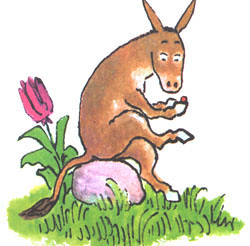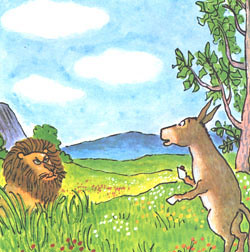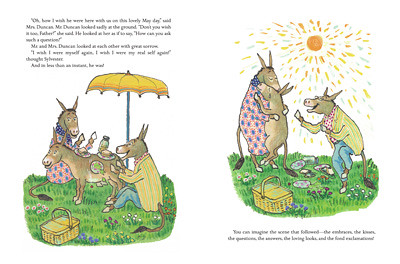"Whenever you read a good book, somewhere in the world a door opens to allow in more light." ~Vera Nazarian
Saturday, October 6, 2012
Wednesday, October 3, 2012
Module 3: Sylvester and the Magic Pebble
Summary
Sylvester and the Magic Pebble by William Steig is the tale of a rock-collecting donkey who stumbles upon a great purple-pebble find while he is out one day. This discovery sets a series of events in motion as the readers and Sylvester discover the pebble's magic that will give the holder anything he/she desires. Eventually this magic comes to bite the poor donkey in the rear when he finds himself face-to-face with danger and makes a hasty wish to be a rock. After fretting over their son's mystic disappearance for many seasons, Sylvester's heartbroken parents go on a picnic at a nearby field. Little do they know this picnic will result in a beautiful reunion with their long-lost son. This is a wonderful tale about the dangers of greed and the importance of family.
Personal Impressions
I personally loved this book. The pictures were beautiful, not too simple or complex, which is why I think it won the Caldecott medal in 1970. Not only were the pictures very well-done, the story was also extremely well-written. When I read it to my three-year-old daughter and 19-month-old son, they enjoyed it (as much as a 3-year-old and 19-month-old enjoy most books). I think it has a great theme about greed and knowing what is truly important in life. It also teaches to be careful what you wish for, a concept that is shown in children's literature quite often.
Professional Review
The following is a review of the book from School Library Journal.
May 25th, 2012
 #55 Sylvester and the Magic Pebble by William Steig (1969)
#55 Sylvester and the Magic Pebble by William Steig (1969)
32 points
I know a little girl who cried when she thought Sylvester would be a rock forever. I’m not sure what it says about me, but that made me love the book even more. The best books are a little scary, aren’t they? – Jessalynn Gale
Overwhelming anguish and transcending joy. Not common fare for picture books. A book in need of an Amber alert. - DaNae Leu
I’ve talked about the psychology at work behind loving one children’s book or another. And no author better represents a person’s individual personality than William Steig. When I print the full list of all the nominations that didn’t quite make it onto the Top 100, you’re going to be shocked by sheer amount of Steig on that list. Everyone has their favorite. Sometimes it’s The Amazing Bone (that’s my personal love). Sometimes it’s Doctor De Soto (though not as often as you might think). But nine times out of ten the title that came up the most was Sylvester. That strange little story of magic, loss, and recovery strikes a deep chord in the hearts and minds of children and parents everywhere.
From the publisher: “One rainy day, Sylvester finds a magic pebble that can make wishes come true. But when a lion frightens him on his way home, Sylvester makes a wish that brings unexpected results. How Sylvester is eventually reunited with his loving family and restored to his own donkey self makes a story that is beautifully tender and perfectly joyful.”
I mean, just look at that cover image! Name me one other picture book where the defining shot of the book is two parents desperately searching and querying their neighbors about the disappearance of their son. It’s heartbreaking.
Now the reissue of this book did a rather wonderful thing that I’ve not seen repeated in any other picture book. When a “deluxe edition” of the book came out the publisher placed in the back the reprinted Caldecott acceptance speech Steig gave forSylvester. This strikes me as a brilliant idea. Would that every Caldecott and Newbery Award and Honor winner had this reprinted in their future editions. For just a little bit of ink you get a pretty cool concept.
The Weston Woods video features the voice of John Lithgow, so I was a little disappointed that I couldn’t find a clip of it. Here instead is a glimpse of a cool looking stage production of the same book:





Library Uses
I think Sylvester and the Magic Pebble would be a great addition to any class or school library. One example would be for the librarian to pair with the reading or language arts teacher and teach a mini-lesson on cause and effect. This type of lesson would be introduced in an elementary setting. In a middle school setting, the librarian could pair with the English Language Arts Reading (ELAR) teacher to do a research lesson on illustrators. I've done a similar lesson where the students researched different illustrators, viewed some of their work in various picture books, discussed medium and style, and then did a mini-research Q & A about the illustrator. It was a big success. I can see the same lesson running more smoothly when the librarian contributes.
References
Bird, E. (2012). Top 100 picture books #55: Sylvester and the magic pebble. School library journal. Retrieved 9 October 2012 from: www.schoollibraryjournal.com.
Steig, W. (1987). Sylvester and the magic pebble. New York, NY: Aladdin Picture Books.
Sylvester and the Magic Pebble by William Steig is the tale of a rock-collecting donkey who stumbles upon a great purple-pebble find while he is out one day. This discovery sets a series of events in motion as the readers and Sylvester discover the pebble's magic that will give the holder anything he/she desires. Eventually this magic comes to bite the poor donkey in the rear when he finds himself face-to-face with danger and makes a hasty wish to be a rock. After fretting over their son's mystic disappearance for many seasons, Sylvester's heartbroken parents go on a picnic at a nearby field. Little do they know this picnic will result in a beautiful reunion with their long-lost son. This is a wonderful tale about the dangers of greed and the importance of family.
Personal Impressions
I personally loved this book. The pictures were beautiful, not too simple or complex, which is why I think it won the Caldecott medal in 1970. Not only were the pictures very well-done, the story was also extremely well-written. When I read it to my three-year-old daughter and 19-month-old son, they enjoyed it (as much as a 3-year-old and 19-month-old enjoy most books). I think it has a great theme about greed and knowing what is truly important in life. It also teaches to be careful what you wish for, a concept that is shown in children's literature quite often.
Professional Review
The following is a review of the book from School Library Journal.
Top 100 Picture Books #55: Sylvester and the Magic Pebble by William Steig
May 25th, 2012
 #55 Sylvester and the Magic Pebble by William Steig (1969)
#55 Sylvester and the Magic Pebble by William Steig (1969)32 points
I know a little girl who cried when she thought Sylvester would be a rock forever. I’m not sure what it says about me, but that made me love the book even more. The best books are a little scary, aren’t they? – Jessalynn Gale
Overwhelming anguish and transcending joy. Not common fare for picture books. A book in need of an Amber alert. - DaNae Leu
I’ve talked about the psychology at work behind loving one children’s book or another. And no author better represents a person’s individual personality than William Steig. When I print the full list of all the nominations that didn’t quite make it onto the Top 100, you’re going to be shocked by sheer amount of Steig on that list. Everyone has their favorite. Sometimes it’s The Amazing Bone (that’s my personal love). Sometimes it’s Doctor De Soto (though not as often as you might think). But nine times out of ten the title that came up the most was Sylvester. That strange little story of magic, loss, and recovery strikes a deep chord in the hearts and minds of children and parents everywhere.
From the publisher: “One rainy day, Sylvester finds a magic pebble that can make wishes come true. But when a lion frightens him on his way home, Sylvester makes a wish that brings unexpected results. How Sylvester is eventually reunited with his loving family and restored to his own donkey self makes a story that is beautifully tender and perfectly joyful.”
I mean, just look at that cover image! Name me one other picture book where the defining shot of the book is two parents desperately searching and querying their neighbors about the disappearance of their son. It’s heartbreaking.
Now the reissue of this book did a rather wonderful thing that I’ve not seen repeated in any other picture book. When a “deluxe edition” of the book came out the publisher placed in the back the reprinted Caldecott acceptance speech Steig gave forSylvester. This strikes me as a brilliant idea. Would that every Caldecott and Newbery Award and Honor winner had this reprinted in their future editions. For just a little bit of ink you get a pretty cool concept.
The Weston Woods video features the voice of John Lithgow, so I was a little disappointed that I couldn’t find a clip of it. Here instead is a glimpse of a cool looking stage production of the same book:





Library Uses
I think Sylvester and the Magic Pebble would be a great addition to any class or school library. One example would be for the librarian to pair with the reading or language arts teacher and teach a mini-lesson on cause and effect. This type of lesson would be introduced in an elementary setting. In a middle school setting, the librarian could pair with the English Language Arts Reading (ELAR) teacher to do a research lesson on illustrators. I've done a similar lesson where the students researched different illustrators, viewed some of their work in various picture books, discussed medium and style, and then did a mini-research Q & A about the illustrator. It was a big success. I can see the same lesson running more smoothly when the librarian contributes.
References
Bird, E. (2012). Top 100 picture books #55: Sylvester and the magic pebble. School library journal. Retrieved 9 October 2012 from: www.schoollibraryjournal.com.
Steig, W. (1987). Sylvester and the magic pebble. New York, NY: Aladdin Picture Books.
Subscribe to:
Posts (Atom)